
French 19th Century Papier Mache Letter Holder with Mother-of-Pearl
A decorative papier mache letter holder, French, 19th century, with mother-of-pearl inlay, a painted bouquet, and enriched with gilding throughout on an ebonised ground, 20 cm high, 24 cm wide, 5.5 cm deep

Antique Papier Mache Sewing Box and Accessories, 19th-20th Century
An antique papier mache sewing box with mother of pearl decoration; together with two antique blotters and an antique spectacle case with lorgnette spectacles, 19th and 20th century, (4 items), the sewing box 26.5 cm wide

19th Century Persian Hand-Painted Papier Mache Box, Antique Decor
An antique Persian papier mache box with hand painted decoration, 19th century, 13 cm wide

Victorian Papier Mache Dish with Mother-of-Pearl Floral Motifs
A Victorian papier mache dish, circa 1870 the circular scallop rim dish inset with painted mother-of-pearl floral motifs to a mosaic border with gilt detailing. Height: 4 cm diameter: 25 cm

19th Century Papier Mache Work Box on Stand with Inlay
Good 19th century papier mache work box on stand, of square form, decorated with flowers and birds in mother of pearl, with upper hinged cover, above a pair of doors, the whole raised on four cabriole legs united by stretchers, 86 x49 cm

Italian Papier Mache Sewing Case with Card, Early 20th Century
An early 20th century Italian sewing case, papier mache case. Length 21 cm. With card.

Red Lacquered Papier Mache Box with Porcelain Inlaid Lid
Red lacquered papier mache with blue and white porcelain inlaid lid, a/f small loss to red lacquer, length 18 cm

Victorian Chinoiserie Lacquered Box with Gilt Decoration, 19th Century
A Victorian parcel gilt and black lacquered Chinoiserie box, late 19th century, the papier mache lacquered fan or incense box, oblong with a hinged and slightly domed cover, decorated throughout with figures outside pavilions in fenced garden setting,…

Antique French Papier Mache Growler Bulldog, Late 19th Century
'Growler' antique French painted papier mache pull along bulldog with growler mechanism, late 19th century, 37 cm high, 45 cm long

Mid 19th Century Papier Mache Desk Compendium, Missing Drawer
An antique papier mache desk compendium, mid 19th century, note: missing lower drawer. 34 cm high, 28 cm wide, 21 cm deep

19th Century Chinoiserie Tray with Exotic Garden and Pavilion Scenes
A gilded and lacquered Chinoiserie tray, 19th century, the papier mache tray of serpentine profile, exquisitely decorated with figural narratives set in exotic garden and pavilion settings, enclosed by painted rope twist and elaborate floral borders in…

Victorian Papier Mache Music Stand with Mother of Pearl Inlay
A Victorian papier mache music stand, the front panel painted and inlaid with mother of pearl, width 29 cm.

19th Century Japanese Papier Mache Wall Bracket with Geishas
19th century Japanese wall bracket, black papier mache decorated with gold and red hand painted Geishas and pagodas, small chip, height 29 cm

19th Century French Chinoiserie Papier Mache Japanese Aesthetic Box
French Chinoiserie papier mache box, 19th century, Japanese aesthetic, round black and gold box decorated with oriental scenes of people in a garden, with lid, height 7.5 cm, diameter 8.5 cm. Provenance: Ben Stoner Antiques, Sydney

Antique Crystal Palace Papier Mache Box with Glass Vignette
Crystal Palace 'From the Grounds' antique English papier mache box with glass vignette scene of the famous exhibition hall in London, mid 19th century, 5.5 cm high, 14 cm wide, 10 cm deep

Victorian Papier Mache Mother of Pearl Serving Tray
A Victorian papier mache serving tray, 19th century the large tray with scalloped edge decorated with inlaid mother of pearl floral motifs and gilt highlights to the bevelled border, length 65 cm, width 50 cm

Victorian Hand Painted Table: Titian's 'Rape of Europa' Adaptation
A rare Victorian Jennens & Bettridge hand painted tabletop, finely painted with an adaption of Titian's 'Rape of Europa' circa 1560. Black lacquer back and edge with gilt scrolls. Impressed maker's mark to reverse. diameter 59 cm. Note: A similar table…

Victorian Paper Mache Tray Table with Gilded Floral Motifs
A Victorian paper mache tray top table, the ebonised wood base with cross stretcher, the paper mache tray decorated with gilded flowers, moths and butterflies on a black ground. 60 x 48 x 50 cm.
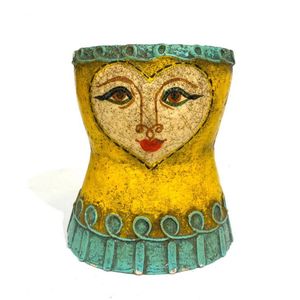
1950 Capistrano Painted Paper Mache Woman Figure (13 cm)
A vintage Capistrano painted paper mache woman figure, c.1950, height 13 cm

Chinoiserie Face Screens: Late Georgian to Early Victorian Collection
A group of twelve late Georgian and early Victorian face screens, second quarter 19th century, three pairs and others similar, variously papier mache, wood, and card, all similarly lacquered or painted with Chinoiserie scenes of figures in gardens and…

Victorian Lacquered Tray on Stand
An early Victorian lacquered papier mache tray on stand, the tray circa 1840, the oval black lacquered tray with gilt decorated border and rolled edge on a later ebonised and gilt stand, the tray 80 cm wide, 64 cm deep, the stand 43 cm high. Provenance:…
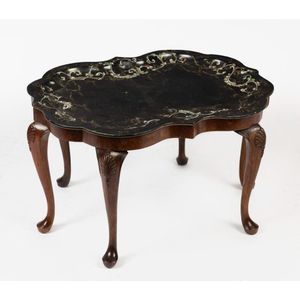
Victorian Papier Mache Tray on Walnut Stand
A Victorian papier mache tray on a later walnut stand, circa 1850, the serpentine shaped tray with floral arabesques with gilt highlights supported on a George I style cabriole leg base with anthemion carved knees, 46 cm high, 81 cm wide, 63 cm deep.…

Victorian Mother-of-Pearl Floral Display Plate
Victorian papier mache display plate, black lacqer finish with inlaid mother-of-pearl and transfer printed floral decoration

19th Century English Papier Mache Mother of Pearl Trays
Lacquered trays, two mid 19th century English papier mache trays, Jennens & Bettridge, with scalloped edges gold paint with, mother of pearl inlay, depicting a boat Coming into harbour, small 52 x 64 cm, large 63 x 80 cm

Georgian Bloodletting Knife with Case, 1790
Georgian spring Lancet Bloodletting knife brass & steel, 5 cm x 2 cm, case 7.2 cm x 3.8 cm x 2 cm high, kid lined papier mache case, c 1790

Georgian Blood-Letting Knife in Papier Mache Case
Georgian spring Lancet - blood Letting knife 5 cm x 2 cm in kid lined papier mache case 7.5 cm x 4 cm x 2.2 cm h, c 1790

Antique Japanese Papier Mache Trays, Meiji Period, 19th Century
Two antique Japanese papier mache trays, Meiji period, 19th century, the larger 26 cm diameter

Victorian Floral Bird Paper Mache Tray - 83cm Width
Victorian paper mache tray with floral and bird decoration, width 83 cm.

Victorian Peacock Papier Mache Trinket Boxes Set
An early Victorian set of papier mache trinket boxes, Jennens & Bettridge, London, circa 1840, the outer box decorated with a peacock in a landscape enclosing five similarly-decorated boxes, impressed marked underside, 5 cm high, 28.5 cm wide, 26 cm deep

Gilded Papier Mache Decanter Coasters, 19th Century
A pair of papier mache decanter coasters, early 19th century, with elaborate gilding on black ground, height 4.8 cm, diameter 13.5 cm. Provenance: The collection of Pamela Massie Greene, Sydney

Stobwasser Madonna and Child Papier Mache Roundel
A German Stobwasser papier mache roundel, first half 19th century, of the Madonna and Child, inscribed 'Madonna und Kind/ Salai' to verso, in later square fluted frame, diameter of roundel 8 cm. Provenance: The property of a gentleman, Sydney

Abalone Inlaid Antique Spectacle Case, 16cm Length
Antique paper mache spectacle case with Abalone shell inlay, length 16 cm

Russian Papier Mache Tea Caddy with Troika Scene
Late 19th century Russian papier mache tea caddy, of deep rectangular form, the cover painted with troika scene, opening to lined interior, with factory stamp to cover, 9 cm x 16 cm x 10 cm

Paua Inlaid Victorian Writing Box
Victorian paper mache writing box, inlaid paua shell with gilt decoration fitted interior with red felt writing slope and inkwells

Floral Mother of Pearl Tray
19th century papier mache floral painted and mother of pearl inlaid tray of quatrefoil outline with gilt decorated border (faults and old repairs) 80 cm width
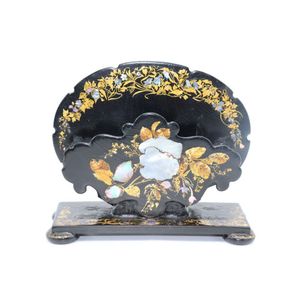
Victorian Mother of Pearl Letter Holder by Jennens & Bettridge
Victorian papier mache letter holder, beautifully decorated with mother of pearl inlays and gilded foliate, marked to base Jennens and Bettridge

Victorian papier mache box with silver inlays
Victorian papier mache box, round lidded box with silver inlays, diameter 9.4 cm

19th Century Russian Hand-Painted Jewellery Box
An antique Russian jewellery box, papier mache with hand-painted courting scene, 19th century, 6 cm high, 12.5 cm wide, 17.5 cm deep

Venetian Paper Mache Mask with Wax Seal
A Genuine Venetian paper mache mask, Manufacturer's wax seal applied to interior. Height 36.5 cm, width 18.5 cm, depth 12 cm

Exotic Bird Papier Mache Tray with Chinese Edge
A 19th century black-ground papier mache tray, in exceptional condition, with a rare faux Chinese calligraphy edge to the cavetto rim, decorated overall with exotic birds amongst gilt foliage and flowers. 63 x 49.5 cm.

Georgian paper mache and metal snuff boxes
Georgian paper mache snuff box with metal inlay, together with one other metal snuff box

Moet & Chandon Papier Mache Champagne Bucket
A 19th century Moet & Chandon champagne bucket, made from papier mache. Decorated with Moet& Chandon branding in gold over a blue ground. Height 22 cm, diameter 20 cm

1857 Lacquered Trays Set
A set of three English lacquered and gilded papier- mache trays, inscribed 1857 verso, 76 x 56 cm, 62 x 47 cm, 41.5 x 32 cm

Victorian Papier Mache Sewing Box
A Victorian papier mache sewing and trinket box, mid 19th century, of upright casket form, the hinged top enclosing fitted compartments for sewing accessories above a pair of doors enclosing drawers, the top, front, and sides with raised shaped panels…

Georgian Snuff Boxes, 18th Century
Four Georgian snuff boxes, wood and papier mache, 18th century, the largest 8.5 cm wide

Victorian Papier Mache Tray on Stand
A Victorian papier mache tray on stand, late 19th century and later, the tray of shaped form, decorated with a gilded edge, together with an antique style fitted stand raised on simulated bamboo legs united by a cross-stretcher, 53 cm high, 78.5 cm wide,…

Victorian Perfume Box with Mother of Pearl Decoration
A Victorian papier mache perfume box, the exterior with traditional mother of pearl and gilded decoration, the interior velvet lined and four perfume bottles in compartments. 13 x 13 x 11 cm.

Victorian Mother of Pearl Jewellery Box
A Victorian papier mache jewellery box, the domed lid decorated with traditional mother of pearl and gilded decoration and with gilded decoration to the front, the interior velvet lined with fittings for a small amount of jewellery, raised on four bun…

Hand-painted Georgian papier mache ale glass box
Georgian papier mache box and cover, of circular form, the cover hand painted with a portrait of a bearded man with an ale glass, diameter 9 cm

Georgian Papier Mache Painted Face Screens (Set of 3)
Three Georgian papier mache painted face screens, the screens of shaped form with turned timber handles, two screens hand decorated with scenes from The Old Curiosity Shop, the other of a river landscape scene with ship (a/f), height 41 cm, 41 cm and 44…
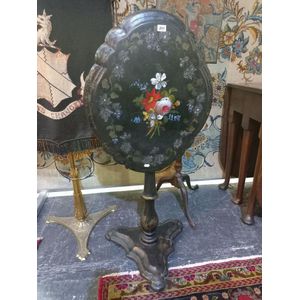
Floral Tilt Top Table with Mother of Pearl Inlay
Papier mache tilt top table, hand painted floral decorations and inlaid mother of pearl A/F
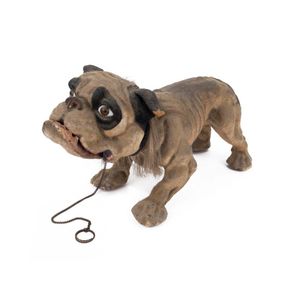
Antique French Bulldog Pull Along Toy
An antique French papier mache, growler, bulldog childs pull along toy, 19th century. With nodding head and pull lead mechanism which opens the dog's mouth and growls. In original working condition, with original glass eyes and wooden castor wheels, the…
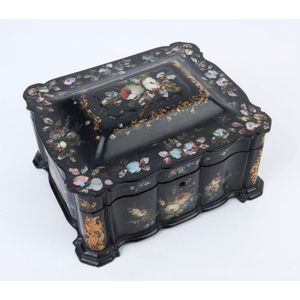
19th Century Hand-Painted Papier Mache English Box
An antique English box, hand-painted papier mache with mother of pearl, mid 19th century, 16 cm high, 28 cm wide, 23 cm deep

Antique Papier Mache Lacquer Corner Shelves
Three papier mache lacquer work folding corner shelves, 1 Japanese with a gilt fishing scene and 2 French with floral transfer decoration and simulated green tortoise shell ground with orchid decoration, circa 1900, (3 items), the largest 42 cm high,19 cm…

19th Century Castle Scene Face Screen with Whale Bone Handle
An antique face screen, papier mache hand-painted with castle scene and whale bone handle, early 19th century, 34 cm high, 27 cm wide

Victorian Mother-of-Pearl Inlaid Jewellery Box
A Victorian papier mache jewellery box, gilt and floral painted decoration, inlaid with mother-of-pearl, the lid opens to reveal jewellery compartments, three drawers behind the two doors to the front. 26 x 24 x 30 cm.

Victorian Abalone Inlay Writing Slope
A Victorian writing slope made in papier mache and abalone shell inlay by Jennens & Bettridge decorated with roses bouquet and motifs in abalone and gilt finishing. 47 cm long and 28 cm wide. Books and documents

Victorian Hand Painted Papier Mache Letter Stands
Two Victorian hand painted papier mache letter stands, one decorated with fern leaves the other with a face of a terrier, the largest 22 cm high

Antique Trays, 19th Century and Later
Four antique trays, 19th century and later, various shapes, sizes and designs, including two tole ware trays two papier mache trays, the largest tray 61 x 44 cm.

Victorian Cherub Silhouette Box
Victorian silvered papier mache lidded box with cherub silhouette decoration

Gilded Butterfly Papier Mache Butler's Tray
Late 19th century Chinoiserie black lacquered papier mache butler's tray decorated with gilded butterflies and foliage on a similar base

18th Century Japanned Tea Caddy by Henry Clay
Tea caddy late 18th century Japanned black, papier mache petit caddy, attributed to Henry clay, 10 x 12 cm

Japanned Babelsberg Castle Stationary Box
Papier mache stationary box mid 19th century, Japanned black, hand painted scene of Babelsberg castle, 13 x 18 x 22 cm

Japanned Papier Mache Visiting Card Case with Mother of Pearl
Visiting card case mid 19th century, Japanned papier mache, mother of pearl decoration, 11 x 7.5 cm
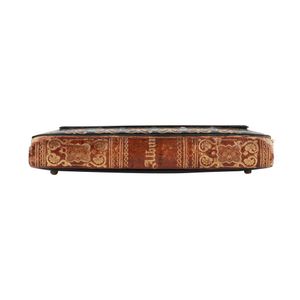
Windsor Castle Autograph Album
Autograph album mid 19th century, papier mache & mother of pearl, scene of Windsor castle, 15 x 12 cm

Gold Leaf Wine Coasters with Vine Leaf Motifs
Pair of wine coasters gold leaf decorated, with motifs of vine leaves, green, papier mache, diameter 14.5 cm
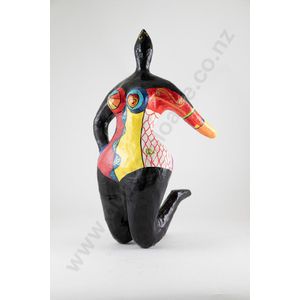
French Papier Mache Figure by Niki de Saint Phalle
Attributed Niki de Saint Phalle (French) papier mache figure, 45 cm height (a/f)

Moorish Denim Bowl
Ruth Levine Moorish denim bowl denim & papier mache. Provenance: the collection of Jayne Goodes OAM. Diameter 30 x 20 cm

Antique Mother of Pearl Inlaid Tea Caddy, 1840
An antique tea caddy, papier mache inlaid with mother of pearl, circa 1840, 11 cm high, 16 cm wide, 12 cm deep
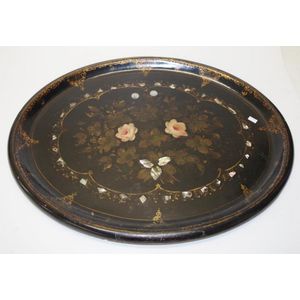
Victorian Papier Mache Tray with Mother of Pearl Inlay
Good Victorian papier mache oval tray with inlaid mother of pearl, c.1840s, width 62 cm approx.

Victorian Papier Mache Butler's Tray and Stand
Victorian papier mache butler's tray and stand, mid 19th century, black shaped rectangular tray with gilt floral rim highlighted in red and blue, raised on faux bamboo legs and stretcher, height 54 cm width 79 cm depth 61 cm. Provenance: Colin Lennox,…
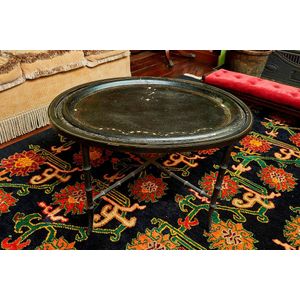
Victorian Papier Mache Butler Tray with Stand
Victorian papier mache butler tray and stand, mid 19th century, black oval tray with gilt and painted floral rim, raised on faux bamboo legs and stretcher, and another tray, height 46 cm width 84 cm depth 68 cm. Provenance: The Collection of Janet and…

Victorian Mother of Pearl Inlaid Papier Mache Box
Victorian papier mache box with mother of pearl inlay, 26 cm wide, 20.5 cm deep, 10.5 cm high

Georgian Hunting Scene Papier Mache Box
Georgian hand painted papier mache box and cover, of rectangular form, decorated with a scene of a figure hunting with dog, length 15 cm

Victorian Gilt Sewing Box with Silk Lining
Victorian papier mache sewing box gilt decoration, with silk taffeta lining, lift out tray, 28 cm length, 22 cm depth, 14 cm height

Victorian Italian Scene Handheld Face Screens
A pair of Victorian paper mache hand held face screens, each painted with scenes from Northern Italy. Turned wooden handles. English circa 1850. Height 41.5 cm

19th Century Papier Mache Jewellery Cabinet
Papier mache jewellery cabinet early 19th century, black Laquer with hand painted, classical village scene with floral interior, gold painted detailing, seven drawers with lift up lid, velvet lined interior, height 43 cm, length 46 cm, depth 37 cm

French Mother of Pearl Wine Table
19th century French papier mache tilt top wine table, inlaid with mother of pearl and hand painted flower decorations

Victorian Floral Standish with Inkwells and Stationery Compartment
A Victorian paper mache standish, two inkwells, stamp holder and stationery compartment, hand painted with flowers and gilt embellishments. 22.5 x 21 x 17 cm.

Swiss Papier Mache Timepiece and Barometer
Swiss timepiece and barometer in papier mache case, 19th century, 46 cm high

Victorian Mother-of-Pearl Sewing Table
Victorian papier mache sewing table, c. 1860, black lacquer, with mother-of-pearl floral inlay, accented with gilt highlights, the hinged hexagonal top opens to reveal a fitted interior, height 75 cm

Floral and Avian Papier Mache Tray on Stand
English papier mache tray on stand, c. 1900, the top decorated with flowers and exotic birds, on faux bamboo stand, height 56.5 cm

Floral Hand-Painted Victorian Paper Mache Tray (Faulty)
Victorian large rectangular paper mache tray raised gallery with hand painted floral decoration (faults)

Victorian Faulty Paper Mache Tray with Serpentine Frame
Victorian paper mache tray serpentine frame (faults)

Victorian Papier Mache Tea Caddy with Gilt and Inlay
Victorian English papier mache' tea caddy with gilt, inlaid shell and ivory decoration, fitted interior, circa 1870, 12 cm x 19 cm, 13 cm high approx.
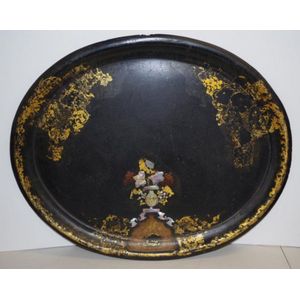
Victorian Mother of Pearl Inlaid Japanned Tray
Victorian black Japanned papier mache tray with mother of pearl inlay, 79 cm x 65 cm

Victorian Inlaid Papier Mache Lady's Compendium
A fine Victorian inlaid papier mache lady's compendium, 19th century, the shaped black lacquer box inlaid with pearl and abalone shell enhanced, with gilt and painted decoration, beautifully fitted with a paper and silk, lined jewellery tray, four…

Victorian Papier Mache Tray and Bowl
A Victorian papier mache tray and a bowl, mid 19th century, the tray with flowers and raised scalloped border, the bowl with a reserve of a painted bird, the papier mache tray 64 cm x 49 cm

Victorian Mother of Pearl Inlaid Papier Mache Box
A Victorian mother of pearl inlaid papier mache box, the hinged top enclosing dual compartment below, two doors enclosing three drawers, all above a flared base, 29 cm high, 26 cm wide, 23 cm deep







 Loading more...
Loading more...